View in other NatureServe Network Field Guides
NatureServe
Montana
Utah
Wyoming
Idaho
Wisconsin
British Columbia
South Carolina
Yukon
California
New York
An Anacolia Moss - Anacolia menziesii
General Description
Plants: Acrocarpous, growing in closely-packed to more open tufts, chartreuse above, brown (Lawton 1971) or reddish-brown below, commonly with prominent rhizoid assemblies low on stem. Stems 3-5 cm (FNA 2014), rarely to 10 cm, frequently branched (Lawton 1971).
Leaves: Stiffly upright and overlapping when dry, spreading when wet, lanceolate from a slightly wider base, narrowing to a long thin point (Lawton 1971), 2.5-4.5 mm in length (FNA 2014); margins curved under below, with teeth (or double teeth) above, pointing toward apex; costa strong, reaching the apex or slightly beyond (Lawton 1971).
Leaf Cells: Basal laminal cells nearly square to short-rectangular (FNA 2014), the walls slightly thickened; alar cells not distinct (Lawton 1971); upper leaf cells oblong-rectangular, smooth or with tiny papillae on outer side, formed from protruding cell ends from when they overlap one another (FNA 2014); margins frequently of 2 cell layers (Lawton 1971).
Phenology
Capsules ripen February-August (FNA 2014).
Range Comments
Known in North America from Baja California, Mexico to Alaska and eastward to Colorado and in Asia from eastern Nepal. The species has also been reported from the south of the Iberian Peninsula (Almeria and Granada) and from Cyprus. Also Spain (Garcia-Zamora 1998). More specifically in North America: Canada: BC; USA: AK, CA, CO, ID, MT, NV, OR, UT, WA, WY; Mexico (FNA 2014). In Montana, known from Flathead, Lake, Lincoln, and Sanders Counties (Elliott 2016).
Observations in Montana Natural Heritage Program Database
Number of Observations: 7
(Click on the following maps and charts to see full sized version)
Map Help and Descriptions
Relative Density
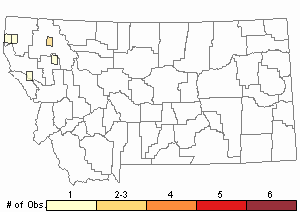
Recency
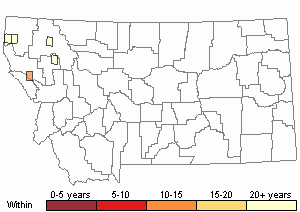
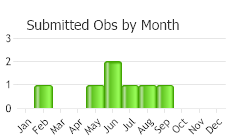
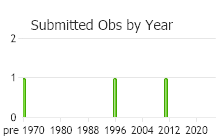
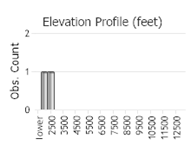 (Observations spanning multiple months or years are excluded from time charts)
(Observations spanning multiple months or years are excluded from time charts)
Habitat
Rocks, shady ravines (FNA 2014), humus and soil on rock ledges; moderate to high elevations (Elliott 2016).
Reproductive Characteristics
Seta is 5-12 mm tall. Capsule is 2-2.8 mm (FNA 2014), somewhat spherical, egg-shaped, or short-cylindric, furrowed but not pleated when dry, the neck scarcely discernible; operculum cone-shaped (Lawton 1971).
Stewardship Responsibility
References
- Literature Cited AboveLegend:
 View Online Publication
View Online Publication Elliott, J.C. and A.K. Pipp. 2018. A Checklist of Montana Mosses (1880-2018). Updated 3 January, 2020. Montana Natural Heritage Program, Helena, Montana. 73 pp.
Elliott, J.C. and A.K. Pipp. 2018. A Checklist of Montana Mosses (1880-2018). Updated 3 January, 2020. Montana Natural Heritage Program, Helena, Montana. 73 pp. Flora of North America Editorial Committee, eds. 2014. Flora of North America North of Mexico. Volume 28. Bryophytes: Mosses, Part 2. Oxford University Press, Inc., NY. xxi + 702 pp.
Flora of North America Editorial Committee, eds. 2014. Flora of North America North of Mexico. Volume 28. Bryophytes: Mosses, Part 2. Oxford University Press, Inc., NY. xxi + 702 pp. Garcia-Zamora, P., R.M. Ros, M.J. Cano, and J. Guerra. 1998. Anacolia menziesii (Bartramiaceae, Musci) A New Species to the European Bryophyte Flora. The Bryologist 101(4):588-593.
Garcia-Zamora, P., R.M. Ros, M.J. Cano, and J. Guerra. 1998. Anacolia menziesii (Bartramiaceae, Musci) A New Species to the European Bryophyte Flora. The Bryologist 101(4):588-593. Lawton, E. 1971. Moss Flora of the Pacific Northwest. Hattori Botanical Laboratory. Japan: Yamabuki-cho, Shinjuku-ku, Tokyo. 362 pages plus appendices.
Lawton, E. 1971. Moss Flora of the Pacific Northwest. Hattori Botanical Laboratory. Japan: Yamabuki-cho, Shinjuku-ku, Tokyo. 362 pages plus appendices.
- Additional ReferencesLegend:
 View Online Publication
View Online Publication
Do you know of a citation we're missing? Elliot, J. C. 1993. Second checklist of Montana mosses. Unpublished report. U.S. Forest Service, Region 1. Missoula, MT. 45 pp.
Elliot, J. C. 1993. Second checklist of Montana mosses. Unpublished report. U.S. Forest Service, Region 1. Missoula, MT. 45 pp. Lawton, E. 1971. Keys for the Identification of the Mosses on the Pacific Northwest. Reprinted from 'Moss Flora of the Pacific Northwest'. Published as Supplement No. 2 of the Journal of the Hattori Botanical Laboratory. Nichinan, Miyazaki, Japan. 66 pp.
Lawton, E. 1971. Keys for the Identification of the Mosses on the Pacific Northwest. Reprinted from 'Moss Flora of the Pacific Northwest'. Published as Supplement No. 2 of the Journal of the Hattori Botanical Laboratory. Nichinan, Miyazaki, Japan. 66 pp.
- Web Search Engines for Articles on "An Anacolia Moss"





